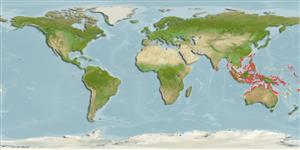>
Ovalentaria/misc (Various families in series Ovalentaria) >
Pomacentridae (Damselfishes) > Pomacentrinae
Etymology: Dischistodus: Greek, di = two + Greek, schistos = fissile stone, Plinius + Greek, odous = teeth (Ref. 45335).
More on author: Bleeker.
Environment: milieu / climate zone / depth range / distribution range
বাস্তুসংস্থান
সামুদ্রিক; ঈষৎ লোনা রীফ সংশ্লিষ্ট; অ_ পরিযায়ী; গভীরতার পরিসীমা 1 - 12 m (Ref. 7247). Tropical; 26°N - 40°S
Indo-West Pacific: Nicobar Islands to Vanuatu, north to the Ryukyu Islands, south to northwest Australia and the Great Barrier Reef (Ref. 9710).
আকৃতি / ওজন / Age
Maturity: Lm ? range ? - ? cm
Max length : 18.5 cm TL পুরুষ/ লিঙ্গ অনিধর্ারিত ; (Ref. 90102)
পৃষ্ঠীয় কাঁটা (মোট ): 13; পৃষ্ঠীয় নরম পাখনা দন্ড (মোট ): 14-16; পায়ূ কাঁটা 2; পায়ূর নরম পাখনা্তুন্ড: 14 - 15.
Adults inhabit lagoons and coastal reefs, usually in silty areas (Ref. 4966). The true D. prosopotaenia ranges from Singapore to Sulawesi while the yellow-breasted variant ranges from Irian Jaya to eastern Australia and Vanuatu (Ref. 48636). May be found solitary or in groups (Ref. 90102). Oviparous, distinct pairing during breeding (Ref. 205). Eggs are demersal and adhere to the substrate (Ref. 205). Males guard and aerate the eggs (Ref. 205). Diurnal species (Ref. 113699).
Life cycle and mating behavior
পরিপক্কতা | প্রজনন | ডিম ছাড়া | ডিমসমূহ | ডিম্বধারন ক্ষমতা | শুককীট
Oviparous, distinct pairing during breeding (Ref. 205). Eggs are demersal and adhere to the substrate (Ref. 205). Males guard and aerate the eggs (Ref. 205).
Allen, G.R., 1991. Damselfishes of the world. Mergus Publishers, Melle, Germany. 271 p. (Ref. 7247)
IUCN Red List Status (Ref. 130435)
Threat to humans
Harmless
Human uses
আরো তথ্য
সূত্র সংখ্যা এ্যাকুয়াকালচার (জলজ পালন) এ্যাকুয়াকালচার নকশা বংশ বংশানুগতিবিদ্যাElectrophoresesউতরাধিকার সুত্রে পাওয়া যোগ্যতারোগ প্রক্রিয়াজাতকরণ NutrientsMass conversion
হাতিয়ার
Special reports
Download XML
ইন্টারনেট সুত্র
Estimates based on models
Preferred temperature (Ref.
123201): 25.4 - 29.3, mean 28.6 °C (based on 2251 cells).
Phylogenetic diversity index (Ref.
82804): PD
50 = 0.5078 [Uniqueness, from 0.5 = low to 2.0 = high].
Bayesian length-weight: a=0.01479 (0.00642 - 0.03409), b=3.00 (2.80 - 3.20), in cm total length, based on LWR estimates for this (Sub)family-body shape (Ref.
93245).
ট্রফিক পর্যায়ে (Ref.
69278): 2.7 ±0.18 se; based on food items.
স্থিতিস্থাপক (Ref.
120179): মাধ্যম , সর্বনিম্ন প্রজন দ্বিগুনের সময় ১.৪-৪.৪ বৎসর (Preliminary K or Fecundity.).
Fishing Vulnerability (Ref.
59153): Low vulnerability (10 of 100).
Nutrients (Ref.
124155): Calcium = 82.7 [45.2, 136.7] mg/100g; Iron = 0.689 [0.421, 1.073] mg/100g; Protein = 19 [18, 20] %; Omega3 = 0.135 [0.086, 0.212] g/100g; Selenium = 19.4 [11.5, 35.3] μg/100g; VitaminA = 109 [36, 318] μg/100g; Zinc = 2.12 [1.51, 2.91] mg/100g (wet weight);
